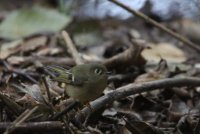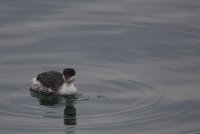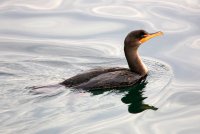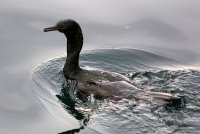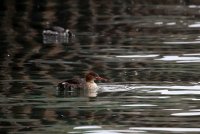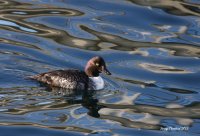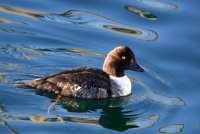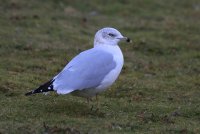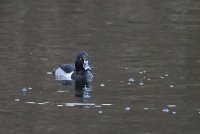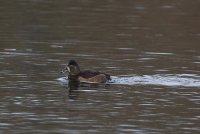You are using an out of date browser. It may not display this or other websites correctly.
You should upgrade or use an alternative browser.
You should upgrade or use an alternative browser.
Wildlife of Edmonds, WA.
- Thread starter Bill Anderson
- Start date
PNWPhotos.com a friendly and growing community of photographers with an interest in the Pacific Northwest region.
We feature a Photography Discussion Forum and Pacific Northwest Photo Gallery. It's a fun and friendly place to talk with other photographers, ask questions, share you knowledge, view and post photos and more!
I wish the entire sequence of photos had been worth saving, as they were quite entertaining.
Last year I had a similar experience rescuing a common murre from a fishing hook on the fishing pier. Handling a murre or an auklet is quite an adventure. While they are not as large as they appear in my photos; up close and personal, their bills look as though they could inflict serious bodily injury to my hand.
You already know the answer to that rhetorical question.
Affiliate Disclosure: We may receive a commision from some of the links and ads shown on this website (Learn More Here)
Friday the 13th my son and I drove to the Group Health clinic in Lynnwood to pick up his medicine. Mini Park (yes, that is its real name) is near the clinic, so we stopped there to look for birds. Many water birds can be found in the pond at Mini Park which cannot be found in nearby Scriber Lake or at the Edmonds marsh. The birds at Mini Park are very close and easily photographed.
http://www.ci.lynnwood.wa.us/PlayLynnwood/Parks/Maple-Mini-Park.htm
Although daytime temperatures have risen above the freezing mark, this gull discovered that parts of the pond were still frozen over when it attempted a landing.
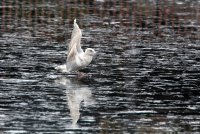
The male northern shoveler is one of my favorite ducks. One was standing on the ice while grooming itself near the shore. In the spring male northern shovelers can be seen spinning tight circles in the water at Mini Park. I assume it is a courtship behavior.
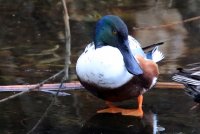
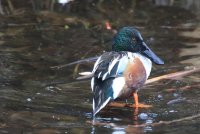
Some buffleheads were also present in the pond. The males are quite iridescent.
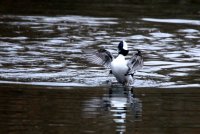
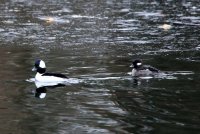
Early in the week, the overnight temps were in the low teens (F) and never rose above the mid 20's all day. I heard many people complain about the "cold", but for the most part it was very sunny and dry. I much preferred that to Friday's weather. Although Friday's daytime temps were in the 40's, it was overcast and damp. What few daylight hours we had were a perpetual twilight with high ISO settings and resulting "soft" photos for my camera.
If I were a vampire, I would spend winters in the Puget Sound region.
http://www.ci.lynnwood.wa.us/PlayLynnwood/Parks/Maple-Mini-Park.htm
Although daytime temperatures have risen above the freezing mark, this gull discovered that parts of the pond were still frozen over when it attempted a landing.

The male northern shoveler is one of my favorite ducks. One was standing on the ice while grooming itself near the shore. In the spring male northern shovelers can be seen spinning tight circles in the water at Mini Park. I assume it is a courtship behavior.


Some buffleheads were also present in the pond. The males are quite iridescent.


Early in the week, the overnight temps were in the low teens (F) and never rose above the mid 20's all day. I heard many people complain about the "cold", but for the most part it was very sunny and dry. I much preferred that to Friday's weather. Although Friday's daytime temps were in the 40's, it was overcast and damp. What few daylight hours we had were a perpetual twilight with high ISO settings and resulting "soft" photos for my camera.
If I were a vampire, I would spend winters in the Puget Sound region.
Last edited:
Saturday was another "twilight day" in the Puget Sound region. Nothing was going on at the marsh. There was a little action at the fishing pier, but most of my photos turned out poor due to the low light.
A lone Heermann's gull was at the marina. According to my local bird book, it should have departed for southern California in October. While it may miss out on breeding, it should be able to survive a winter up here along with the resident winged beach rats should it decide to stay.
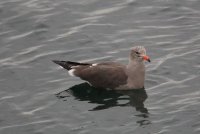
Several cormorants were fighting over a fish. I took a lot of shots, but due to lousy light and distance, these were the only ones that came out halfway decent with the help of post processing.
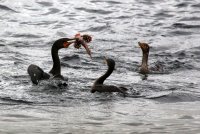
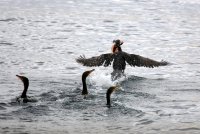
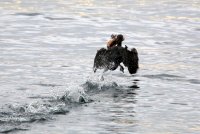
We had an adventure with a rhinoceros auklet, although I don't think it was this one. Sorry for the noise from the 12800 ISO setting of my 5D MkIII. Donations to my 1DX fund will be much appreciated. http://www.kenmorecamera.com/p-18994-canon-eos-1dx-body.aspx
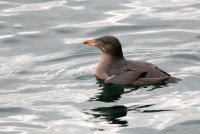
Rhino auklet adventure: A young man fishing from the pier hooked one and reeled it up to the pier. The bird kept squirming and got the fishing line wound around itself. The young man, a retired U of W professor who was visiting the pier, and I subdued the bird, untangled and removed the fishing line, then released it.
A lone Heermann's gull was at the marina. According to my local bird book, it should have departed for southern California in October. While it may miss out on breeding, it should be able to survive a winter up here along with the resident winged beach rats should it decide to stay.

Several cormorants were fighting over a fish. I took a lot of shots, but due to lousy light and distance, these were the only ones that came out halfway decent with the help of post processing.



We had an adventure with a rhinoceros auklet, although I don't think it was this one. Sorry for the noise from the 12800 ISO setting of my 5D MkIII. Donations to my 1DX fund will be much appreciated. http://www.kenmorecamera.com/p-18994-canon-eos-1dx-body.aspx

Rhino auklet adventure: A young man fishing from the pier hooked one and reeled it up to the pier. The bird kept squirming and got the fishing line wound around itself. The young man, a retired U of W professor who was visiting the pier, and I subdued the bird, untangled and removed the fishing line, then released it.
Last edited:
Nice rescue and good shots, Bill. You done good on those cormorant shots.
I wish the entire sequence of photos had been worth saving, as they were quite entertaining.
Last year I had a similar experience rescuing a common murre from a fishing hook on the fishing pier. Handling a murre or an auklet is quite an adventure. While they are not as large as they appear in my photos; up close and personal, their bills look as though they could inflict serious bodily injury to my hand.
Last edited:
I didn't get out photographing Sunday, which was another twilight day. Here are three more shots from Saturday.
Horned grebe. I think it should be renamed zombie grebe.
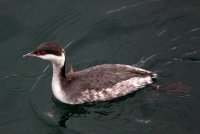
Double-crested cormorant.
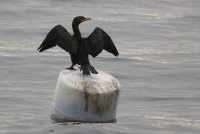
Female goldeneye. The black bill and the shape of its head indicates it is a common goldeneye, not a Barrow's goldeneye.
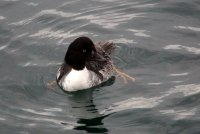
Horned grebe. I think it should be renamed zombie grebe.

Double-crested cormorant.

Female goldeneye. The black bill and the shape of its head indicates it is a common goldeneye, not a Barrow's goldeneye.

Last edited:
Monday cleared up nicely so Terry, Daren,and I went out to the fishing pier. I experimented with a circular polarizing filter to cut down the glare and reflection off the water. The filter does that quite well, but coupling it with 1/1000 shutter speed and f/8.0 aperature setting drove the ISO as high as 10000 and 12800. The resulting "noise" made some of the photos very "soft" looking.
Female common goldeneye. It might be the same one in the photo above as it was at the same location beneath the fishing pier.
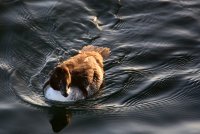
Double-crested cormorant eating lunch.
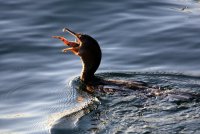
Double-crested cormorant drying its wings. They must do this as they don't have glands to secrete oil to make their feathers water repellant. This might sound like a disadvantage for a water bird, but it results in the bird having less buoyancy so it can dive faster.
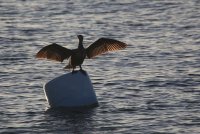
Surf scoter doing the "walk on water" take off.
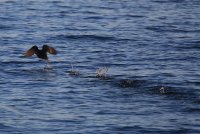
Double-crested cormorant flying past the fishing pier.
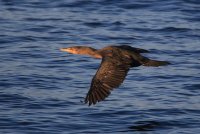
Female common goldeneye. It might be the same one in the photo above as it was at the same location beneath the fishing pier.

Double-crested cormorant eating lunch.

Double-crested cormorant drying its wings. They must do this as they don't have glands to secrete oil to make their feathers water repellant. This might sound like a disadvantage for a water bird, but it results in the bird having less buoyancy so it can dive faster.

Surf scoter doing the "walk on water" take off.

Double-crested cormorant flying past the fishing pier.

Last edited:
After sunny Monday, we returned to twilight Tuesday (12/17). It was so dark and gloomy that I removed the teleconverter from my camera so I would have all available aperature settings on my 4.5-5.6/100-400L zoom.
A brief trip to the marsh while my son Daren was working out at the gym only yielded a (Cooper's?) hawk perched in a tree on the southern hedge/tree line. The shot was just not worth dragging out and setting up the 2.8/400L, to which I can attach my 2x teleconverter for the equivalent of an 800mm telephoto lens.
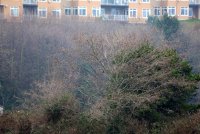
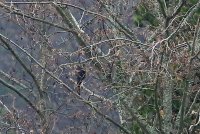
Back at the ranch, Dexter, my backyard hummer, posed for me and allowed me get fairly close.
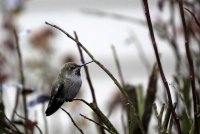
A neighbor and fellow member of the Bird Fest planning committee and her daughter wanted to go out birding with Daren and me after lunch, so we agreed to meet at Yost Park. Terry could not make it, which more than guaranteed that we would see some fantastic birds.
A small flock of varied thrush was present at the T intersection of two trails. I have always thought that the bright blue and orange plumage of the thrush which makes it so appealing to me as a photographer is poor camouflage that would make it so appealing to predators of the non-photographic type. I discovered that its colors make perfect camouflage against the fallen leaves where the thrush typically likes to forage.
Can you spot the thrush in this photo taken with the 100mm end of my 100-400L telephoto zoom?
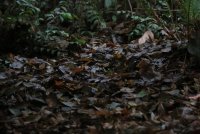
The thrush moved, which made it a little easier to find with the 400mm end of the zoom.
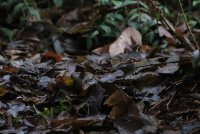
A brief trip to the marsh while my son Daren was working out at the gym only yielded a (Cooper's?) hawk perched in a tree on the southern hedge/tree line. The shot was just not worth dragging out and setting up the 2.8/400L, to which I can attach my 2x teleconverter for the equivalent of an 800mm telephoto lens.


Back at the ranch, Dexter, my backyard hummer, posed for me and allowed me get fairly close.

A neighbor and fellow member of the Bird Fest planning committee and her daughter wanted to go out birding with Daren and me after lunch, so we agreed to meet at Yost Park. Terry could not make it, which more than guaranteed that we would see some fantastic birds.
A small flock of varied thrush was present at the T intersection of two trails. I have always thought that the bright blue and orange plumage of the thrush which makes it so appealing to me as a photographer is poor camouflage that would make it so appealing to predators of the non-photographic type. I discovered that its colors make perfect camouflage against the fallen leaves where the thrush typically likes to forage.
Can you spot the thrush in this photo taken with the 100mm end of my 100-400L telephoto zoom?

The thrush moved, which made it a little easier to find with the 400mm end of the zoom.

Last edited:
While their bright feathers offer protective camouflage on the ground, they make the thrush very visible in a tree. Robins are also members of the thrush family. Varied thrush and robins can be easily mistaken for each other in low light when all you can see is a silhouette and a pattern of movement.
I was using high ISO settings due to the the poor light. Close cropping caused the photos to look soft due to the noise.
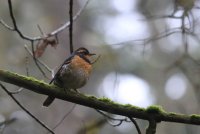
Backing off on the cropping may have shown too much background for a perfect bird book shot, but it reduced the noise.
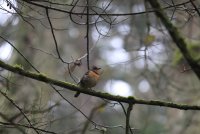
The trees at the bottom of the ravine where the barred owl pair hung out all summer are completely devoid of leaves, which would expose the owls to the evil minions of the Dark Lord and any other birds which care to harass them. I led my expedition to the top of the ravine at the NE corner of the park, where a thick stand of Doug firs creates a nice canopy for the owls to hide under. I thought our best chance of spotting one or both owls was there.
The mother and fellow member of the Bird Fest planning committee was the first to spot the owl perched on the branch of a Doug fir ahead and downhill of us. As is typical, the owl just watched us as we walked directly under it. It was so dark that I was shooting in Tv mode at 1/125, with the ISO set at 51200. This pegged out the aperature to its maximum of f/5.6.
Even with the camera's noise reduction set to full, I knew the shots were going to be very noisy. I therefore got close enough to get full frame shots which would require no cropping.
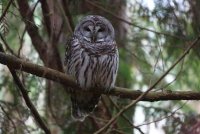
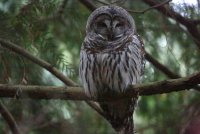
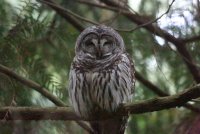
We walked down the north side of the ravine, crossed Shell Creek, and walked up the service road on the south side of the ravine. Although we only saw one owl, we heard two owls calling to each other about an hour before sunset. Both calls appeared to be emanating from that NE corner of the park where we had been.
I was using high ISO settings due to the the poor light. Close cropping caused the photos to look soft due to the noise.

Backing off on the cropping may have shown too much background for a perfect bird book shot, but it reduced the noise.

The trees at the bottom of the ravine where the barred owl pair hung out all summer are completely devoid of leaves, which would expose the owls to the evil minions of the Dark Lord and any other birds which care to harass them. I led my expedition to the top of the ravine at the NE corner of the park, where a thick stand of Doug firs creates a nice canopy for the owls to hide under. I thought our best chance of spotting one or both owls was there.
The mother and fellow member of the Bird Fest planning committee was the first to spot the owl perched on the branch of a Doug fir ahead and downhill of us. As is typical, the owl just watched us as we walked directly under it. It was so dark that I was shooting in Tv mode at 1/125, with the ISO set at 51200. This pegged out the aperature to its maximum of f/5.6.
Even with the camera's noise reduction set to full, I knew the shots were going to be very noisy. I therefore got close enough to get full frame shots which would require no cropping.



We walked down the north side of the ravine, crossed Shell Creek, and walked up the service road on the south side of the ravine. Although we only saw one owl, we heard two owls calling to each other about an hour before sunset. Both calls appeared to be emanating from that NE corner of the park where we had been.
Last edited:
Each year the Tulalip tribes publishes a calendar in their native Lushootseed language. The theme of the 2014 calendar is birds. Seven of my photos were used in the calendar. Instructions for downloading or purchasing calendars can be found on the home page. Photo credits are on the last page of the calendar.
http://www.tulaliplushootseed.com/
http://www.tulaliplushootseed.com/
Too bad I couldn't join you all. Or perhaps its because I didn't join you that it was successful
You already know the answer to that rhetorical question.
My neighbor who spotted the owl during yesterday's expedition to Yost Park wanted to see a northern shoveler; so Wednesday (12/18), she, Daren, and I met Terry at Mini Park in Lynnwood.
A small group of hooded mergansers was in the pond.
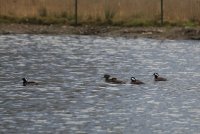
One of the males dove and came up with a fish.
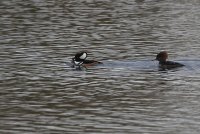
The resident muskrat swam to its burrow on the north bank under 200th St. You can tell it is a muskrat and not a beaver by its smaller size and three "humps" (head, back, and tail) above the water as it swims. A beaver has only two "humps" (head and back) above the water as it swims.
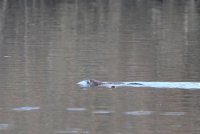
A small flock of American wigeons was on the east side of the pond.

The sought after (male) northern shoveler swam up to the west bank near us to look for food among some cattails. Shovelers have a patch of bright blue feathers on the underside of their wings which is only visible when they fly.
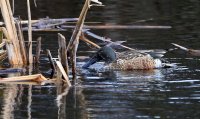
A small group of hooded mergansers was in the pond.

One of the males dove and came up with a fish.

The resident muskrat swam to its burrow on the north bank under 200th St. You can tell it is a muskrat and not a beaver by its smaller size and three "humps" (head, back, and tail) above the water as it swims. A beaver has only two "humps" (head and back) above the water as it swims.

A small flock of American wigeons was on the east side of the pond.

The sought after (male) northern shoveler swam up to the west bank near us to look for food among some cattails. Shovelers have a patch of bright blue feathers on the underside of their wings which is only visible when they fly.

Last edited:
PNWPhotos.com is a participant in the Amazon Services LLC Associates Program, an affiliate advertising program designed to provide a means for sites to earn advertising fees by advertising and linking to amazon.com

